Related Research Articles

Solder is a fusible metal alloy used to create a permanent bond between metal workpieces. Solder is melted in order to wet the parts of the joint, where it adheres to and connects the pieces after cooling. Metals or alloys suitable for use as solder should have a lower melting point than the pieces to be joined. The solder should also be resistant to oxidative and corrosive effects that would degrade the joint over time. Solder used in making electrical connections also needs to have favorable electrical characteristics.
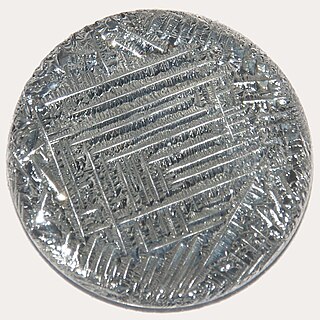
Tellurium is a chemical element; it has symbol Te and atomic number 52. It is a brittle, mildly toxic, rare, silver-white metalloid. Tellurium is chemically related to selenium and sulfur, all three of which are chalcogens. It is occasionally found in its native form as elemental crystals. Tellurium is far more common in the Universe as a whole than on Earth. Its extreme rarity in the Earth's crust, comparable to that of platinum, is due partly to its formation of a volatile hydride that caused tellurium to be lost to space as a gas during the hot nebular formation of Earth.
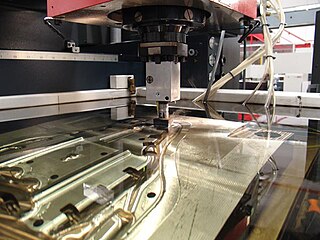
Electrical discharge machining (EDM), also known as spark machining, spark eroding, die sinking, wire burning or wire erosion, is a metal fabrication process whereby a desired shape is obtained by using electrical discharges (sparks). Material is removed from the work piece by a series of rapidly recurring current discharges between two electrodes, separated by a dielectric liquid and subject to an electric voltage. One of the electrodes is called the tool-electrode, or simply the tool or electrode, while the other is called the workpiece-electrode, or work piece. The process depends upon the tool and work piece not making physical contact. Extremely hard materials like carbides, ceramics, titanium alloys and heat treated tool steels that are very difficult to machine using conventional machining can be precisely machined by EDM.
A period 5 element is one of the chemical elements in the fifth row of the periodic table of the chemical elements. The periodic table is laid out in rows to illustrate recurring (periodic) trends in the chemical behaviour of the elements as their atomic number increases: a new row is begun when chemical behaviour begins to repeat, meaning that elements with similar behaviour fall into the same vertical columns. The fifth period contains 18 elements, beginning with rubidium and ending with xenon. As a rule, period 5 elements fill their 5s shells first, then their 4d, and 5p shells, in that order; however, there are exceptions, such as rhodium.

Spot welding is a type of electric resistance welding used to weld various sheet metal products, through a process in which contacting metal surface points are joined by the heat obtained from resistance to electric current.

Brazing is a metal-joining process in which two or more metal items are joined by melting and flowing a filler metal into the joint, with the filler metal having a lower melting point than the adjoining metal.

Cadmium telluride (CdTe) is a stable crystalline compound formed from cadmium and tellurium. It is mainly used as the semiconducting material in cadmium telluride photovoltaics and an infrared optical window. It is usually sandwiched with cadmium sulfide to form a p–n junction solar PV cell.
Cadmium zinc telluride, (CdZnTe) or CZT, is a compound of cadmium, zinc and tellurium or, more strictly speaking, an alloy of cadmium telluride and zinc telluride. A direct bandgap semiconductor, it is used in a variety of applications, including semiconductor radiation detectors, photorefractive gratings, electro-optic modulators, solar cells, and terahertz generation and detection. The band gap varies from approximately 1.4 to 2.2 eV, depending on composition.
In metalworking, a filler metal is a metal added in the making of a joint through welding, brazing, or soldering.

Sodium tellurite is an inorganic tellurium compound with formula Na2TeO3. It is a water-soluble white solid and a weak reducing agent. Sodium tellurite is an intermediate in the extraction of the element, tellurium; it is a product obtained from anode slimes and is a precursor to tellurium.
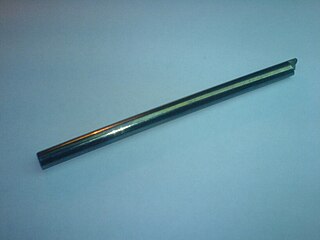
Bismuth telluride is a gray powder that is a compound of bismuth and tellurium also known as bismuth(III) telluride. It is a semiconductor, which, when alloyed with antimony or selenium, is an efficient thermoelectric material for refrigeration or portable power generation. Bi2Te3 is a topological insulator, and thus exhibits thickness-dependent physical properties.
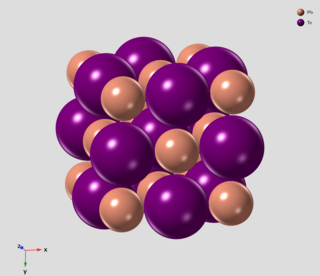
Lead telluride is a compound of lead and tellurium (PbTe). It crystallizes in the NaCl crystal structure with Pb atoms occupying the cation and Te forming the anionic lattice. It is a narrow gap semiconductor with a band gap of 0.32 eV. It occurs naturally as the mineral altaite.
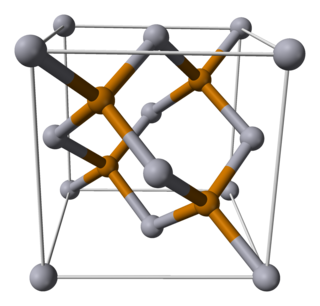
Mercury telluride (HgTe) is a binary chemical compound of mercury and tellurium. It is a semi-metal related to the II-VI group of semiconductor materials. Alternative names are mercuric telluride and mercury(II) telluride.
Copper–tungsten is a mixture of copper and tungsten. As copper and tungsten are not mutually soluble, the material is composed of distinct particles of one metal dispersed in a matrix of the other one. The microstructure is therefore rather a metal matrix composite instead of a true alloy.

Antimony telluride is an inorganic compound with the chemical formula Sb2Te3. As is true of other pnictogen chalcogenide layered materials, it is a grey crystalline solid with layered structure. Layers consist of two atomic sheets of antimony and three atomic sheets of tellurium and are held together by weak van der Waals forces. Sb2Te3 is a narrow-gap semiconductor with a band gap 0.21 eV; it is also a topological insulator, and thus exhibits thickness-dependent physical properties.
Copper telluride may refer to:
The telluride bromides are chemical compounds that contain both telluride ions (Te2−) and bromide ions (Br−). They are in the class of mixed anion compounds or chalcogenide halides.
The telluride iodides are chemical compounds that contain both telluride ions (Te2−) and iodide ions (I−). They are in the class of mixed anion compounds or chalcogenide halides.
Copper(I) telluride is an inorganic compound with the chemical formula Cu2Te. It can be synthesized by reacting elemental copper and tellurium with a molar ratio of 2:1 at 1200 °C in a vacuum. Cu2Te has potential applications in thermoelectric elements and in solar cells, where it is alloyed with cadmium telluride to create a heterojunction.
Dysprosium(III) telluride is an inorganic compound, one of the tellurides of dysprosium, with the chemical formula Dy2Te3, where Dy is in the +3 oxidation state.
References
- ↑ "Usage Patterns for Tellurium", A Report of the NMAB (National Materials Advisory Board) (Report), no. NMAB-257, National Research Council, p. 10, Aug 1969
- ↑ Warne, D.F., ed. (2000), Newnes Electrical Engineer's Handbook, Newnes, 3.4.11 Copper and its alloys, p.52, ISBN 0750648791
- ↑ Rao, P.N., ed. (2009), "11. Unconventional Machining Processes", Manufacturing Technology, vol. 2 Metal and Machine Tools (2nd ed.), Tata McGraw-Hill (New Delhi), § 11.2.5 Electrodes, p.305, ISBN 978-0070087699
- ↑ Borisova, Z. (1981), Glassy Semiconductors, Springer, 7. The Arsenic-Tellurium-Copper System, p.423, doi:10.1007/978-1-4757-0851-6, ISBN 978-1-4757-0853-0
Further reading
- Pashinkin, A.S.; Federov, V.A. (June 2003). "Phase equilibria in the Cu–Te system". Inorganic Materials. 39 (6): 539–554. doi:10.1023/A:1024003932461.
- Blachnik, R.; Lasocka, M.; Walbrecht, U. (15 July 1983). "The system copper-tellurium". Journal of Solid State Chemistry. 48 (3): 431–438. Bibcode:1983JSSCh..48..431B. doi:10.1016/0022-4596(83)90102-0.